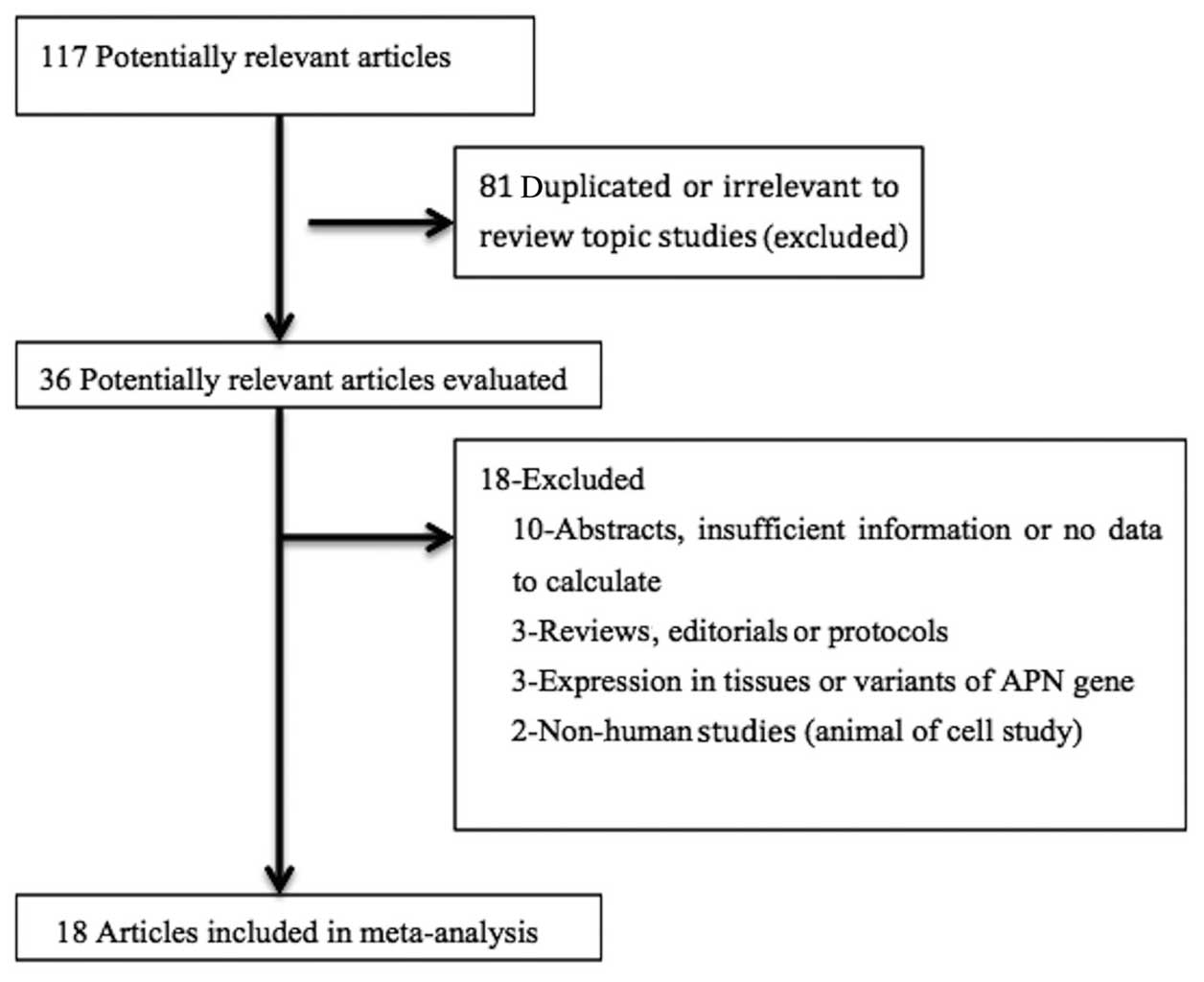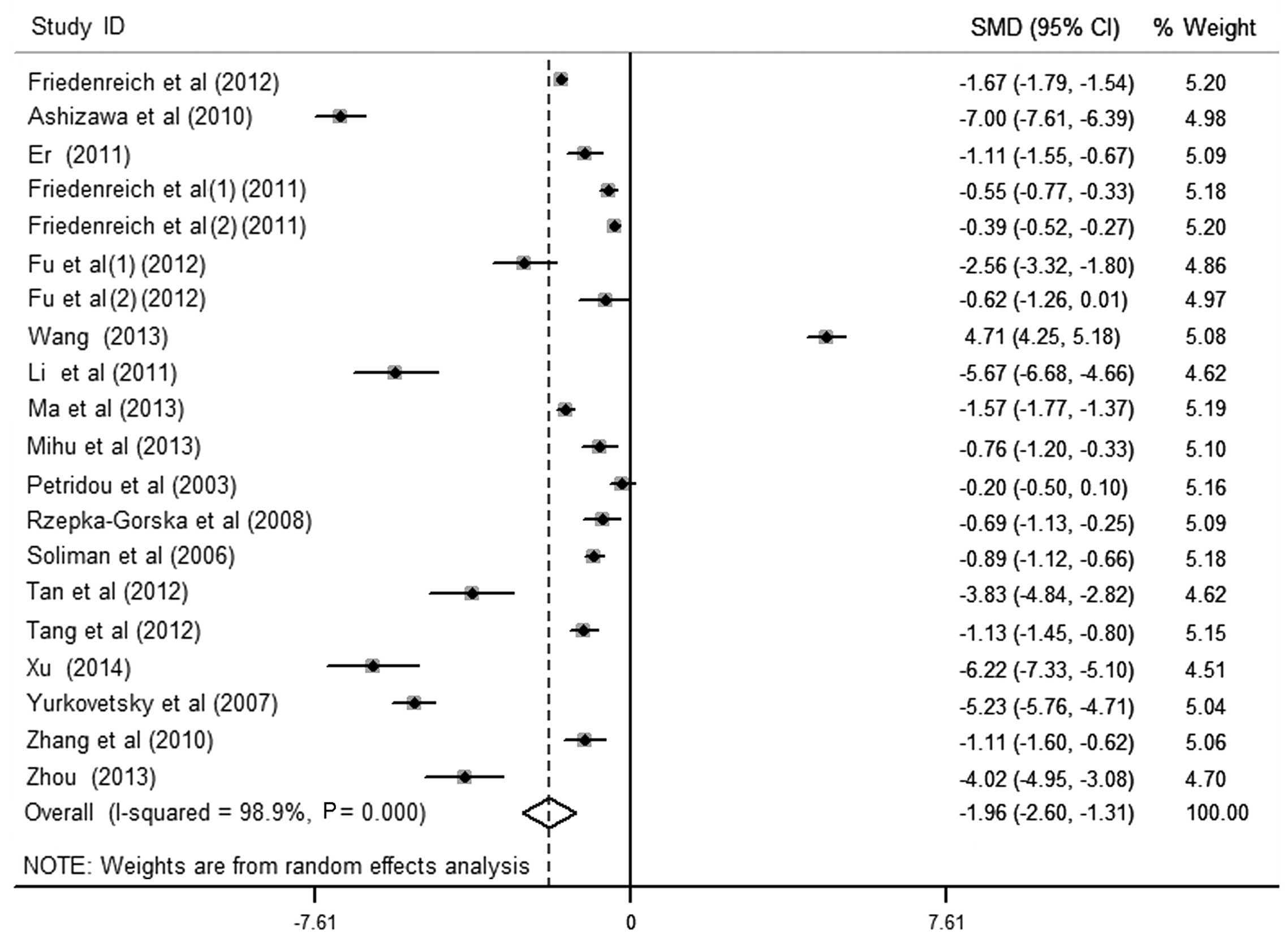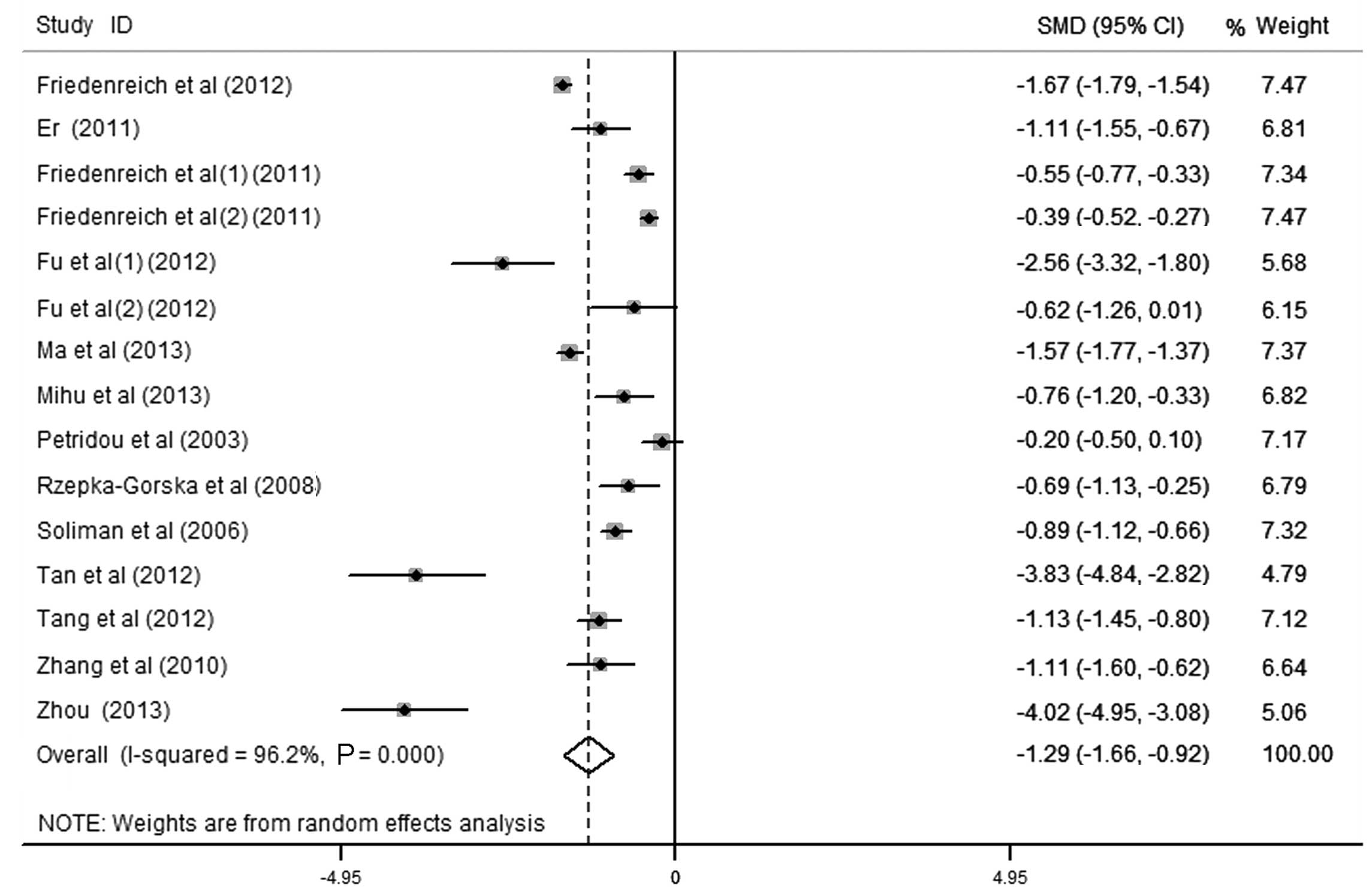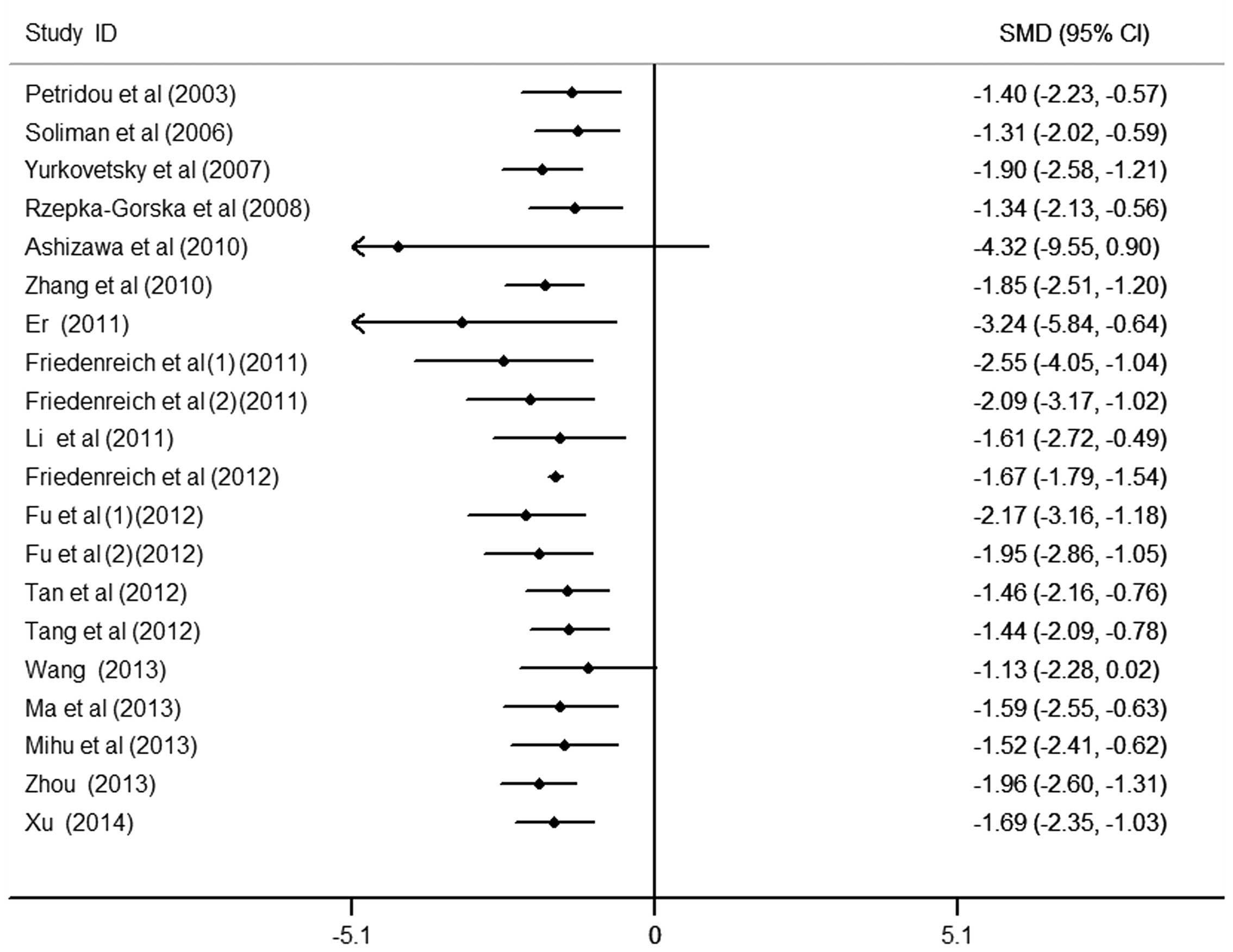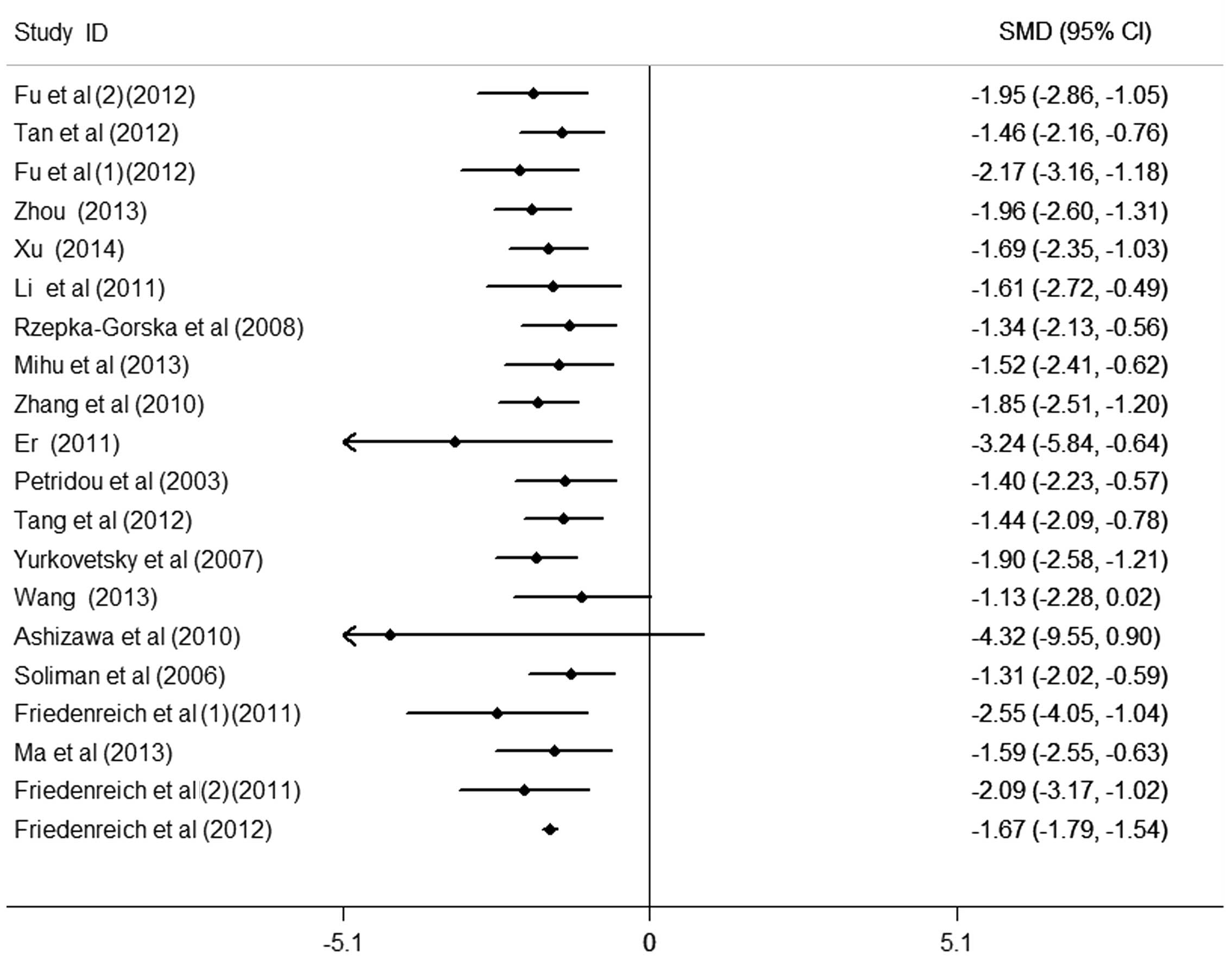|
1
|
Burzawa JK, Schmeler KM, Soliman PT, Meyer
LA, Bevers MW, Pustilnik TL, Anderson ML, Ramondetta LM,
Tortolero-Luna G, Urbauer DL, et al: Prospective evaluation of
insulin resistance among endometrial cancer patients. Am J Obstet
Gynecol. 204:355.e1–355.e7. 2011. View Article : Google Scholar
|
|
2
|
Lucenteforte E, Bosetti C, Talamini R,
Montella M, Zucchetto A, Pelucchi C, Franceschi S, Negri E, Levi F
and La Vecchia C: Diabetes and endometrial cancer: Effect
modification by body weight, physical activity and hypertension. Br
J Cancer. 97:995–998. 2007. View Article : Google Scholar : PubMed/NCBI
|
|
3
|
Yamauchi N, Takazawa Y, Maeda D, Hibiya T,
Tanaka M, Iwabu M, Okada-Iwabu M, Yamauchi T, Kadowaki T and
Fukayama M: Expression levels of adiponectin receptors are
decreased in human endometrial adenocarcinoma tissues. Int J
Gynecol Pathol. 31:352–357. 2012. View Article : Google Scholar : PubMed/NCBI
|
|
4
|
Yin XH, Jia HY, Xue XR, Yang SZ and Wang
ZQ: Clinical analysis of endometrial cancer patients with obesity,
diabetes and hypertension. Int J Clin Exp Med. 7:736–743.
2014.PubMed/NCBI
|
|
5
|
Fader AN, Arriba LN, Frasure HE and von
Gruenigen VE: Endometrial cancer and obesity: Epidemiology,
biomarker, prevention and survivorship. Gynecol Oncol. 114:121–127.
2009. View Article : Google Scholar : PubMed/NCBI
|
|
6
|
Linkov F, Edwards R, Balk J, Yurkovetsky
Z, Stadterman B, Lokshin A and Taioli E: Endometrial hyperplasia,
endometrial cancer and prevention: Gaps in existing research of
modifiable risk factors. Eur J Cancer. 44:1632–1644. 2008.
View Article : Google Scholar : PubMed/NCBI
|
|
7
|
Xu XT, Xu Q, Tong JL, Zhu MM, Huang ML,
Ran ZH and Xiao SD: Meta-analysis: Circulating adiponectin levels
and risk of colorectal cancer and adenoma. J Dig Dis. 12:234–244.
2011. View Article : Google Scholar : PubMed/NCBI
|
|
8
|
Cust AE, Armstrong BK, Friedenreich CM,
Slimani N and Bauman A: Physical activity and endometrial cancer
risk: A review of the current evidence, biologic mechanisms and the
quality of physical activity assessment methods. Cancer Causes
Control. 18:243–258. 2007. View Article : Google Scholar : PubMed/NCBI
|
|
9
|
Schouten LJ, Goldbohm RA and van den
Brandt PA: Anthropometry, physical activity, and endometrial cancer
risk: Results from the Netherlands Cohort Study. J Natl Cancer
Inst. 96:1635–1638. 2004. View Article : Google Scholar : PubMed/NCBI
|
|
10
|
Barb D, Pazaitou-Panayiotou K and
Mantzoros CS: Adiponectin: A link between obesity and cancer.
Expert Opin Investig Drugs. 15:917–931. 2006. View Article : Google Scholar : PubMed/NCBI
|
|
11
|
Calle EE and Kaaks R: Overweight, obesity
and cancer: Epidemiological evidence and proposed mechanisms. Nat
Rev Cancer. 4:579–591. 2004. View
Article : Google Scholar : PubMed/NCBI
|
|
12
|
Joshi RK and Lee SA: Obesity related
adipokines and colorectal cancer: A review and meta-analysis. Asian
Pac J Cancer Prev. 15:397–405. 2014. View Article : Google Scholar : PubMed/NCBI
|
|
13
|
Renehan AG, Roberts DL and Dive C: Obesity
and cancer: Pathophysiological and biological mechanisms. Arch
Physiol Biochem. 114:71–83. 2008. View Article : Google Scholar : PubMed/NCBI
|
|
14
|
Dalamaga M, Diakopoulos KN and Mantzoros
CS: The role of adiponectin in cancer: A review of current
evidence. Endocr Rev. 33:547–594. 2012. View Article : Google Scholar : PubMed/NCBI
|
|
15
|
Kelesidis I, Kelesidis T and Mantzoros CS:
Adiponectin and cancer: A systematic review. Br J Cancer.
94:1221–1225. 2006. View Article : Google Scholar : PubMed/NCBI
|
|
16
|
Housa D, Housová J, Vernerová Z and
Haluzík M: Adipocytokines and Cancer. Physiol Res. 55:233–244.
2006.PubMed/NCBI
|
|
17
|
Roberts DL, Dive C and Renehan AG:
Biological mechanisms linking obesity and cancer risk: New
perspectives. Annu Rev Med. 61:301–316. 2010. View Article : Google Scholar : PubMed/NCBI
|
|
18
|
Friedenreich CM, Langley AR, Speidel TP,
Lau DC, Courneya KS, Csizmadi I, Magliocco AM, Yasui Y and Cook LS:
Case-control study of markers of insulin resistance and endometrial
cancer risk. Endocr Relat Cancer. 19:785–792. 2012. View Article : Google Scholar : PubMed/NCBI
|
|
19
|
Ashizawa N, Yahata T, Quan J, Adachi S,
Yoshihara K and Tanaka K: Serum leptin-adiponectin ratio and
endometrial cancer risk in postmenopausal female subjects. Gynecol
Oncol. 119:65–69. 2010. View Article : Google Scholar : PubMed/NCBI
|
|
20
|
Er LX and Liu FQ: Roles of VEGF,
adiponectin and EGFR in endometrial adenocarcinoma. Yi Xue Zong
Shu. 17:1417–1418. 2011.(In Chinese).
|
|
21
|
Friedenreich CM, Biel RK, Lau DC, Csizmadi
I, Courneya KS, Magliocco AM, Yasui Y and Cook LS: Case-control
study of the metabolic syndrome and metabolic risk factors for
endometrial cancer. Cancer Epidemiol Biomarkers Prev. 20:2384–2395.
2011. View Article : Google Scholar : PubMed/NCBI
|
|
22
|
Fu JR, Lu LN, Yu LP, Wang DY and Ding KS:
Serum changes of adiponectin, insulin resistance and their
correlation in endometrial cancer patients. Zhonghua Fu Chan Ke Za
Zhi. 47:672–675. 2012.(In Chinese). PubMed/NCBI
|
|
23
|
Wang G: Analysis of relationship between
serum adiponectin level and insulin resisitance index in endomerial
carcinoma. Shi Yong Ai Zheng Za Zhi She. 28:599–601. 2013.(In
Chinese).
|
|
24
|
Li SP, Huang XH and Zhang AL: Expression
of serum adiponectin in patients with endometrial cancer and its
clinical significance. J Clin Res. 28:1252–1253. 2011.
|
|
25
|
Ma Y, Liu Z, Zhang Y and Lu B: Serum
leptin, adiponectin and endometrial cancer risk in Chinese women. J
Gynecol Oncol. 24:336–341. 2013. View Article : Google Scholar : PubMed/NCBI
|
|
26
|
Mihu D, Ciortea R and Mihu CM: Abdominal
adiposity through adipocyte secretion products, a risk factor for
endometrial cancer. Gynecol Endocrinol. 29:448–451. 2013.
View Article : Google Scholar : PubMed/NCBI
|
|
27
|
Petridou E, Mantzoros C, Dessypris N,
Koukoulomatis P, Addy C, Voulgaris Z, Chrousos G and Trichopoulos
D: Plasma adiponectin concentrations in relation to endometrial
cancer: A case-control study in Greece. J Clin Endocrinol Metab.
88:993–997. 2003. View Article : Google Scholar : PubMed/NCBI
|
|
28
|
Rzepka-Górska I, Bedner R, Cymbaluk-Płoska
A and Chudecka-Głaz A: Serum adiponectin in relation to endometrial
cancer and endometrial hyperplasia with atypia in obese women. Eur
J Gynaecol Oncol. 29:594–597. 2008.PubMed/NCBI
|
|
29
|
Soliman PT, Wu D, Tortolero-Luna G,
Schmeler KM, Slomovitz BM, Bray MS, Gershenson DM and Lu KH:
Association between adiponectin, insulin resistance, and
endometrial cancer. Cancer. 106:2376–2381. 2006. View Article : Google Scholar : PubMed/NCBI
|
|
30
|
Tan ZQ, Liu FX and Long D: Expression and
clinical significance of serum adiponectin in patients with
endometrial cancer. Guangdong Med J. 33:1757–1759. 2012.
|
|
31
|
Tang JM, Xiao Q and Fang Y: Study on the
risk ofactors related to sign the comprehensive endometrial cancer
and metabolism. Zhejiang Prev Med. 24:69–70. 2012.
|
|
32
|
Xu L: Relationship between the expression
of adiponectin in serum and type-I Endometrial Carcinoma. Hua Xi Yi
Xue. 29:736–737. 2014.(In Chinese).
|
|
33
|
Yurkovetsky Z, Ta'asan S, Skates S, Rand
A, Lomakin A, Linkov F, Marrangoni A, Velikokhatnaya L, Winans M,
Gorelik E, et al: Development of multimarker panel for early
detection of endometrial cancer. High diagnostic power of
prolactin. Gynecol Oncol. 107:58–65. 2007. View Article : Google Scholar : PubMed/NCBI
|
|
34
|
Zhang LZ, Wen K and Liu R: Change and
significance of serum adiponectin level in patients with
endometrial carcinoma. Shangdong Med. 50:4–5. 2010.
|
|
35
|
Zhou MN: Research on expression of
adiponectin in serum of the patients with endometrial cancer and
its clinical significance. Zhong Guo Wei Sheng Chan Ye Za Zhi She.
10:156–158. 2013.(In Chinese).
|
|
36
|
Wells GA, Shea B, O'connell D, et al: The
Newcastle-Ottawa Scale (NOS) for assessing the quality of
nonrandomised studies in meta-analyses. http://www.ohri.ca/programs/clinical_epidemiology/oxford.aspACCESS
DATE month, day, year.
|
|
37
|
Stroup DF, Berlin JA, Morton SC, Olkin I,
Williamson GD, Rennie D, Moher D, Becker BJ, Sipe TA and Thacker
SB: Meta-analysis of observational studies in epidemiology: A
proposal for reporting. Meta-analysis Of Observational Studies in
Epidemiology (MOOSE) group. JAMA. 283:2008–2012. 2000. View Article : Google Scholar : PubMed/NCBI
|
|
38
|
Pinthus JH, Kleinmann N, Tisdale B,
Chatterjee S, Lu JP, Gillis A, Hamlet T, Singh G, Farrokhyar F and
Kapoor A: Lower plasma adiponectin levels are associated with
larger tumor size and metastasis in clear-cell carcinoma of the
kidney. Eur Urol. 54:866–873. 2008. View Article : Google Scholar : PubMed/NCBI
|
|
39
|
Hozo SP, Djulbegovic B and Hozo I:
Estimating the mean and variance from the median, range, and the
size of a sample. BMC Med Res Methodol. 5:132005. View Article : Google Scholar : PubMed/NCBI
|
|
40
|
DerSimonian R: Meta-analysis in the design
and monitoring of clinical trials. Stat Med. 15:1237–1252. 1996.
View Article : Google Scholar : PubMed/NCBI
|
|
41
|
Higgins JP and Thompson SG: Quantifying
heterogeneity in a meta-analysis. Stat Med. 21:1539–1558. 2002.
View Article : Google Scholar : PubMed/NCBI
|
|
42
|
Leimu R and Koricheva J: Cumulative
meta-analysis: A new tool for detection of temporal trends and
publication bias in ecology. Proc Biol Sci. 271:1961–1966. 2004.
View Article : Google Scholar : PubMed/NCBI
|
|
43
|
Begg CB and Mazumdar M: Operating
characteristics of a rank correlation test for publication bias.
Biometrics. 50:1088–1101. 1994. View
Article : Google Scholar : PubMed/NCBI
|
|
44
|
Egger M, Davey Smith G, Schneider M and
Minder C: Bias in meta-analysis detected by a simple, graphical
test. BMJ. 315:629–634. 1997. View Article : Google Scholar : PubMed/NCBI
|
|
45
|
Dallal CM, Brinton LA, Bauer DC, Buist DS,
Cauley JA, Hue TF, Lacroix A, Tice JA, Chia VM, Falk R, et al:
B~FIT Research Group: Obesity-related hormones and endometrial
cancer among postmenopausal women: A nested case-control study
within the B~FIT cohort. Endocr Relat Cancer. 20:151–160. 2013.
View Article : Google Scholar : PubMed/NCBI
|
|
46
|
Modesitt SC, Geffel DL, Via JL and Weltman
A: Morbidly obese women with and without endometrial cancer: Are
there differences in measured physical fitness, body composition,
or hormones? Gynecol Oncol. 124:431–436. 2012. View Article : Google Scholar : PubMed/NCBI
|
|
47
|
Cust AE, Kaaks R, Friedenreich C, Bonnet
F, Laville M, Lukanova A, Rinaldi S, Dossus L, Slimani N, Lundin E,
et al: Plasma adiponectin levels and endometrial cancer risk in
pre- and postmenopausal women. J Clin Endocrinol Metab. 92:255–263.
2007. View Article : Google Scholar : PubMed/NCBI
|
|
48
|
Dal Maso L, Augustin LS, Karalis A,
Talamini R, Franceschi S, Trichopoulos D, Mantzoros CS and La
Vecchia C: Circulating adiponectin and endometrial cancer risk. J
Clin Endocrinol Metab. 89:1160–1163. 2004. View Article : Google Scholar : PubMed/NCBI
|















